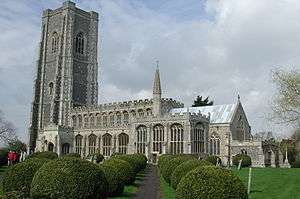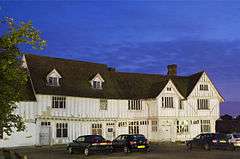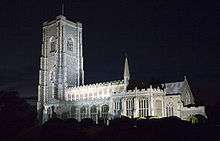Lavenham
| Lavenham | |
|---|---|
 High Street, Lavenham | |
 Lavenham Lavenham shown within Suffolk | |
| Population | 1,722 (2011)[1] |
| OS grid reference | TL915491 |
| • London | 76.3 miles |
| Civil parish |
|
| District | |
| Shire county | |
| Region | |
| Country | England |
| Sovereign state | United Kingdom |
| Post town | SUDBURY |
| Postcode district | CO10 |
| Dialling code | 01787 |
| Police | Suffolk |
| Fire | Suffolk |
| Ambulance | East of England |
| EU Parliament | East of England |
| UK Parliament | |

Lavenham is a village, civil parish and electoral ward in Suffolk, England. It is noted for its Guildhall, Little Hall, 15th-century church, half-timbered medieval cottages and circular walks. In the medieval period it was among the twenty wealthiest settlements in England.[2] Today, it is a popular day-trip destination for people from across the country along with another historic wool town in the area, Long Melford.
History
Before the Norman conquest, the manor of Lavenham had been held by the thegn Ulwin or Wulwine. In 1086 the estate was in the possession of Aubrey de Vere I, ancestor of the Earls of Oxford. He had already had a vineyard planted there. The Vere family continued to hold the estate until 1604, when it was sold to Sir Thomas Skinner.[3]
Lavenham prospered from the wool trade in the 15th and 16th centuries, with the town's blue broadcloth being an export of note. By the late 15th century, the town was among the richest in the British Isles, paying more in taxation than considerably larger towns such as York and Lincoln.[4] Several merchant families emerged, the most successful of which was the Spring family.
The town's prosperity at this time can be seen in the lavishly constructed wool church of St Peter and St Paul, which stands on a hill at the top end of the main high street. The church, completed in 1525, is excessively large for the size of the village and with a tower standing 141 ft (43 m) high it lays claim to being the highest village church tower in Britain. Other buildings also demonstrate the town's medieval wealth. Lavenham Wool Hall was completed in 1464.
The Guildhall of the catholic guild of Corpus Christi was built in 1529 and stands in the centre of the village overlooking the market square. When visiting the town in 1487, Henry VII fined several Lavenham families for displaying too much wealth. However, during the 16th century Lavenham's industry was badly affected by Dutch refugees settled in Colchester, who produced cloth that was cheaper and lighter than Lavenham's, and also more fashionable.[2] Cheaper imports from Europe also aided the settlement's decline, and by 1600 it had lost its reputation as a major trading town. This sudden and dramatic change to the town's fortune is the principal reason for so many medieval and Tudor buildings remaining unmodified in Lavenham, as subsequent generations of citizens did not have the wealth required to rebuild in the latest styles.
During the reign of Henry VIII, Lavenham was the scene of serious resistance to Wolsey’s ‘Amicable Grant’, a tax being raised in England to pay for war with France. However, this was happening without the consent of parliament. In 1525, 10,000 men from Lavenham and the surrounding villages took part in a serious uprising that threatened to spread to the nearby counties of Essex and Cambridgeshire. However, the revolt was suppressed for the King by the Dukes of Norfolk and Suffolk, with the aid of local families.[5] Elizabeth I visited the town during a Royal Progress of East Anglia in 1578.
Like most of East Anglia, Lavenham was staunchly Parliamentarian throughout the Civil Wars of the 1640s. Most local landowners, such as Sir Nathaniel Barnardiston, Sir Philip Parker and Sir William Spring, were strong advocates of the Parliamentarian cause. There is no record of the town ever being directly involved in the conflict, although the townspeople did provide a troop of soldiers to aid in Parliament's Siege of Colchester in 1648. A grammar school opened in the town in 1647. The settlement was struck by plague in 1666 and 1699. Small pox struck in 1712 and 1713, killing over one in six of Lavenham's residents.
In the late 18th century, the village was home to poet Jane Taylor, and it may have been while living in Shilling Street that she wrote the poem The Star, from which the lyrics for the nursery rhyme Twinkle Twinkle Little Star are taken. Colchester and Ongar, both in Essex, also have claims to be the site of composition of the poem.
Like many East Anglian settlements, Lavenham was home to an airbase in the Second World War II – Air Force Station Lavenham, an American Air Force airfield.[6] USAAF Station 137 was manned by the US Army Air Force 487th Bombardment Group between 1944 and 1945. The airfield, actually located a few miles away in Alpheton, has since been returned to arable farmland, though some evidence of its structures and buildings remains, including the control tower.
In the 1960s, a new area of council housing was built in the north of the village, centred on Spring Street, Spring Close and Spring Lane. In 1980 the marijuana smuggler Howard Marks was arrested in the bar of the Swan Hotel.[7]
John Lennon and Yoko Ono filmed their experimental film Apotheosis with a hot-air balloon in Lavenham's Market Place in December 1969.[8]
Geography
The village is located around five miles northeast of the town of Sudbury. Situated in a relatively hilly area, Lavenham is situated on a ridge on the western bank of the River Brett. The ridge is intersected by two small valleys, breaking it into three parts; the church is located atop the southernmost section, the marketplace on the central part, while the northernmost section is topped by the remains of a windmill.
The southernmost valley contains a brook running between the pond at Lavenham Hall and the River Brett, though it was covered by a culvert 500 years ago, and Water Street built over the top.[8] There have been attempts to give the culverts Scheduled Monument status as a "rare early example of municipal plumbing".[8] The northernmost valley also contains a small stream as well as being the former route of the abandoned railway line.
Transport
Lavenham is located on the A1141, the main road between Hadleigh and Bury St Edmunds. HGV traffic has been an issue for the village's narrow streets.[9]
The village formerly had a railway station on the Long Melford-Bury St Edmunds branch line, which was opened on 9 August 1865.[10] There were plans for the Hadleigh branch line to be extended to Lavenham, though these never came to fruition.[11] The line was an important goods route during the Second World War and was guarded by numerous Type 22 pillboxes, most of which are still visible in the surrounding farmland. The railway station was closed to passengers on 10 April 1961 as part of the Beeching Axe, with a goods service surviving until April 1965.[10] Today the disused line is used as a public footpath and is a designated nature reserve.[12]
Education
The village is served by Lavenham Community Primary School, which currently caters for pupils aged 5–11.[13] The school feeds into Thomas Gainsborough School.[14]
Demography
Historical population
| Historical population of Lavenham | ||||||||||
| Year | 1801 | 1811 | 1821 | 1831 | 1841 | 1851 | 1861 | 1871 | 1881 | 1891 |
|---|---|---|---|---|---|---|---|---|---|---|
| Population | 1,776 | 1,711 | 1,898 | 2,107 | 1,871 | 1,811 | 1,823 | 1,886 | 1,838 | 1,908 |
| Year | 1901 | 1911 | 1921 | 1931 | 1951 | 1961 | 1971 | 1981 | 1991 | 2001 |
| Population | 2,018 | 1,963 | 1,620 | 1,451 | 1,489 | 1,305 | 1,480 | 1,750 | ||
|
Census: Regional District 1801–1971[15] | ||||||||||
Notable residents
Notable residents of Lavenham have included Lord Mayor of London Thomas Cooke, author George Ruggle, art critic Robert Langton Douglas, poet Stephen Spender,[16] actor Eamon Boland and artist Roy Turner Durrant.
Lavenham in popular culture
Lavenham's Market Square was a location for the 1968 Vincent Price film Witchfinder General. In 1986 a more contemporary film Playing Away, about a visiting cricket team from Brixton, was also filmed there.[17] The Market Square is the setting of John Lennon and Yoko Ono's 1970 film Apotheosis.[18] Other filmmakers who have used the village as a location include Stanley Kubrick[7] and Pier Paolo Pasolini.[19] In 2010, under conditions of strict secrecy, scenes from Harry Potter and the Deathly Hallows – Part 1 and Part 2 were filmed there.[20]
Lavenham is also the setting for the final episode of the mid-1990s BBC TV drama Lovejoy. The episode, which aired in December 1994, was titled 'Last Tango in Lavenham'.[21]
It is believed that the distorted, or "crooked", appearance of many of the town's buildings inspired the poem "A Crooked Little Man."[22]
Lavenham pictures
 Lavenham Guildhall, established by one of four religious guilds in Lavenham in 1529
Lavenham Guildhall, established by one of four religious guilds in Lavenham in 1529 The church of St Peter and St Paul at night
The church of St Peter and St Paul at night Lavenham Wool Hall, built in 1464
Lavenham Wool Hall, built in 1464 The Crooked House. The timbers have warped over time causing the upper floor to look crooked – hence the name.
The Crooked House. The timbers have warped over time causing the upper floor to look crooked – hence the name. Prentice Street, Lavenham
Prentice Street, Lavenham High Street, Lavenham
High Street, Lavenham
References
- ↑ "Parish/Ward population 2011". Retrieved 12 September 2015.
- 1 2 Roper, Corinne. "Lavenham: The man-made wonder of Suffolk". BBC Suffolk. Retrieved 28 January 2008.
- ↑ Copinger, The Manors of Suffolk, vol. I, pp. 117–118.
- ↑ "History of Lavenham Guildhall". National Trust. Retrieved 7 June 2017.
- ↑ The Springs of Lavenham; Barbara McClenaghan, Cam. 1924
- ↑ "Lavenham Airfield". www.lavenham.co.uk. Retrieved 28 January 2008.
- 1 2 Scriven, Marcus (19 September 2010). "Turn right for the 15th century: It's no surprise Lavenham is the perfect Harry Potter setting". Daily Mail. Retrieved 28 July 2018.
- 1 2 3 "When John Lennon brought a lot of hot air to Suffolk". East Anglia Daily Times. 7 December 2010. Retrieved 25 September 2018.
- ↑ Satellite lorries blight Lavenham BBC News, 15 November 2004
- 1 2 Lavenham Disused Stations
- ↑ The story of Hadleigh's railway Archived 10 April 2010 at the Wayback Machine. Hadleigh.org.uk
- ↑ Lavenham Railway Walk Archived 6 July 2008 at the Wayback Machine. Suffolk County Council
- ↑ "Lavenham Community Primary School | Community Directory". infolink.suffolk.gov.uk. Retrieved 29 July 2018.
- ↑ Thomas Gainsborough School. "Admissions Policy for September 2018" (PDF). Retrieved 29 July 2018.
- ↑ "Lavenham, Suffolk – Population Statistics". Vision of Britain. Retrieved 10 April 2009.
- ↑ 'Stephen Spender: A Literary Life' by John Sutherland
- ↑ screenonline: Playing Away (1986)
- ↑ "A Century of Artists' Film in Great Britain". Tate Britain. Retrieved 4 April 2014.
- ↑ IMDB.
- ↑ "Suffolk Free Press". Archived from the original on 28 March 2010. Retrieved 20 May 2010.
- ↑ IMDB
- ↑ Bob Taylor (12 September 2011). "Lavenham, England: Part one of four great little places". The Washington Times. Archived from the original on 2014-04-13. Retrieved 2 December 2014.
External links
| Wikivoyage has a travel guide for Lavenham. |
| Wikimedia Commons has media related to Lavenham. |